Mycelium for professionals
Mycelium for professionals
Product categories
Mushroom species
fruiting bodies
form shelves easily
resistant to other fungal contaminants
All prices on this website are EX WORKS = VAT and transport cost are not included. More information see below.
This species is the medicinal Ganoderma, used as a tradicional chinese medicine called ‘Reishi’ or ‘Lingzhi’, which is often mistaken as ‘G. lucidum’ in literature and everyday uses. See further information about the matter below.
EN: Reishi, Lingzhi I FR: Ganoderme luisant I DE: Lackporling I NL: Lakzwam I ES: Pipa I HU: Pecsétviaszgomba
According to the literature, G. lucidum is generally considered to be identical with the familiar, traditional Asian medicine, namely “Ling-zhi” in China and “Mannentake” or “Reishi” in Japan (e.g. Paterson 2006, Wasser 2005). Nevertheless, it has long been recognised that the name G. lucidum was erroneously applied to the morphologically somewhat similar East Asian Ganoderma collections (Moncalvo et al. 1995, Pegler and Yao 1996) and the most often incorrectly used binomial within the genus (Seo and Kirk 2000).
However, based on phylogenetic studies, it should be considered that the distribution range of G. lucidum s. str. is limited to Europe and northern and southwestern China (Yang and Feng 2013, Zhou et al. 2015). Several recent molecular studies proved that the specimens originated from Japan, Korea or Eastern China, and previously identified as G. lucidum are identical with the recently described G. lingzhi S. H. Wu, Y. Cao et Y. C. Dai or G. sichuanense J. D. Zhao et X. Q. Zhang sensu Wang et al. (Cao et al. 2012, Kwon et al. 2016, Wang et al. 2012, Yang and Feng 2013, Yao et al. 2013, Zhou et al. 2015).
In a recent study, german scientists were examining two of Mycelia’s Ganoderma ‘lucidum’ strains (M9720 and M9724) for identifying on the species level with molecular techniques and determining the triglyceride composition.
The study found that the 9724 is not G. lucidum but G. lingzhi and it has a significantly higher triglyceride content, hence it is more valuable as a medicinal mushroom (Hennicke et al., 2016).
Cao, Y., Wu, S. H. and Dai, Y. C. (2012): Species clarification of the prize medicinal Ganoderma mushroom “Lingzhi”. – Fungal Diversity 56(1): 49–62. http://dx.doi.org/10.1007/s13225-012-0178-5
Hennicke, F., Cheikh-Ali, Z., Liebisch, T., Maciá-Vicente, J. G., Bode, H. B. and Piepenbring, M. (2016) Distinguishing commercially grown Ganoderma lucidum from Ganoderma lingzhi from Europe and East Asia on the basis of morphology, molecular phylogeny, and triterpenic acid profiles. Phytochemistry 127: 29–37.
Kwon, O.-C., Park, Y.-J., Kim, H.-I., Kong, W.-S., Cho, J.-H. and Lee, C.-S. (2016): Taxonomic position and species identity of the cultivated Yeongji ‘Ganoderma lucidum’ in Korea. – Mycobiology 44(1): 1–6. http://dx.doi.org/10.5941/myco.2016.44.1.1
Moncalvo, J.- M., Wang, H.-F. and Hseu, R.-S. (1995): Gene phylogeny of the Ganoderma lucidum complex based on ribosomal DNA sequences: comparison with traditional taxonomic characters. – Mycol. Res. 99(12): 1489–1499. http://dx.doi.org/10.1016/s0953-7562(09)80798-3
Paterson, R. R. M. (2006): Ganoderma – a therapeutic fungal biofactory. – Phytochemistry 67(18): 1985–2001. http://dx.doi.org/10.1002/chin.200650268
Pegler, D. N. and Yao, Y. J. (1996): Oriental species of Ganoderma section Ganoderma. – In: Wasser, S. P. (eds): Botany and mycology for the next millennium: collection of scientific articles devoted to the 70th Anniversary of Academician Sytnik KM. Kholodny NG Institute of Botany, National Academy of Sciences of Ukraine, Kyiv, pp. 336–347.
Seo, G. S. and Kirk, P. M. (2000): Ganodermataceae: nomenclature and classi cation. – In: Flood, J., Bridge, P. D. and Holderness, M. (eds): Ganoderma diseases of perennial crops. CABI, Wallingford, pp. 3–22. http://dx.doi.org/10.1079/9780851993881.0003
Wasser, S. P. (2005): Reishi or Ling Zhi (Ganoderma lucidum). – In: Paul, M., Coates, P. M., Blackman, M. R., Cragg, G. M., Levine, M., Moss, J. and White, J. D. (eds): Encyclopaedia of Dietary Supplements. CRC Press, pp. 603–622. http://dx.doi.org/10.1201/b13959-62
Yang, Z. L. and Feng, B. (2013): What is the Chinese “Lingzhi”? – a taxonomic mini-review. – Mycology 4(1): 1–4.
Yao, Y. J., Wang, X. C. and Wang, B. (2013): Epitypification of Ganoderma sichuanense J. D. Zhao & X. Q. Zhang (Ganodermataceae). – Taxon 62(5): 1025–1031. http://dx.doi.org/10.12705/625.10
Zhao, J. D. (1989): The Ganodermataceae in China. – Biblioth. Mycol. 132: 1–176.
Zhou, L. W., Cao, Y., Wu, S. H., Vlasák, J., Li, D. W., Li, M. J. and Dai, Y. C. (2015): Global diversity of the Ganoderma lucidum complex (Ganodermataceae, Polyporales) inferred from morphology and multilocus phylogeny. – Phytochemistry 114: 7–15. http://dx.doi.org/10.1016/j.phytochem.2014.09.023
Wang, X. C., Xi, R. J., Li, Y., Wang, D. M. and Yao, Y. J. (2012): The species identity of the widely cultivated Ganoderma, ‘G. lucidum’ (Ling-zhi), in China. – Plos One 7(7): e40857. http://dx.doi.org/10.1371/journal.pone.0040857
MOTHER CULTURE | STAGE 1
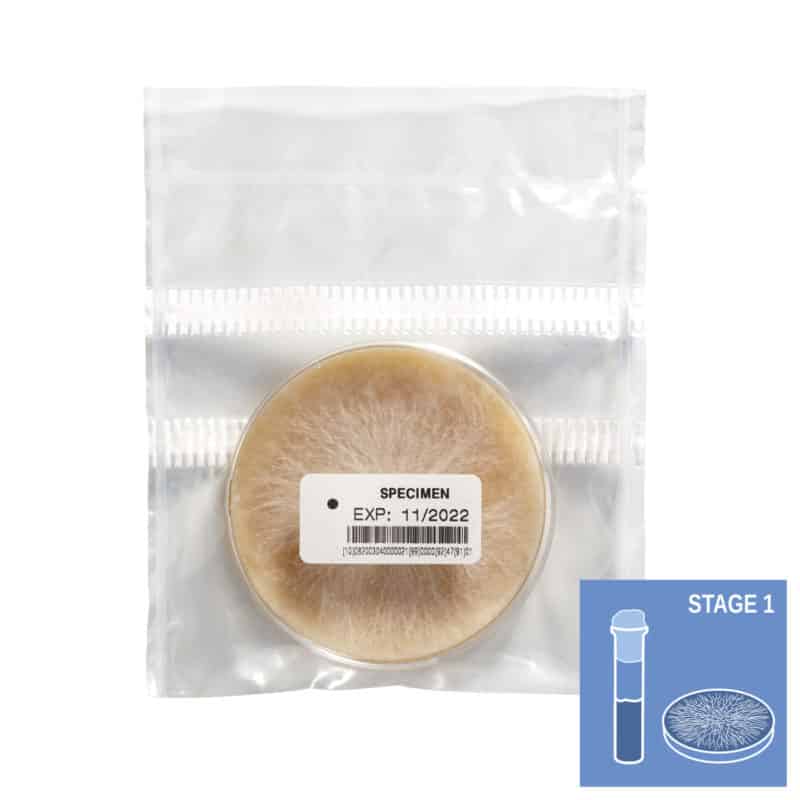
PETRIDISHES, TEST TUBES AND CRYOVIALS
Transported by courier. Cultures and cryovials are less sensitive to overheating than spawn and can be shipped all year round as long as the outside temperature is below 30°C (86°F) and as long as they are kept out of the sun.
MOTHER SPAWN | STAGE 2
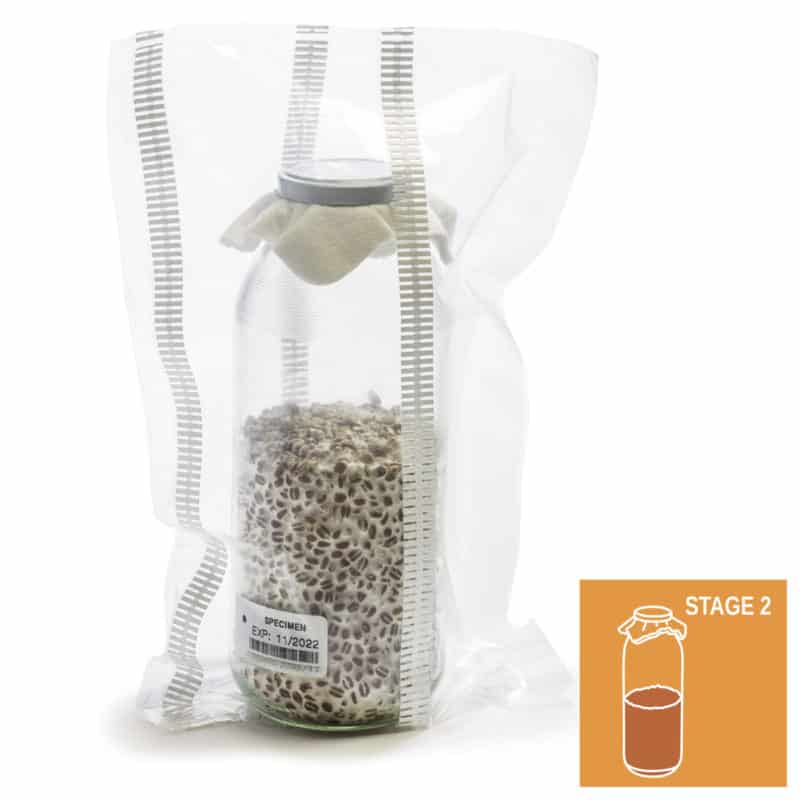
BOTTLE AND LIQUID
Transported by courier. Bottles are not so sensitive to overheating and can be shipped most of the year as long as the outside temperature is below 30°C (86°F) and as long as they are kept out of the sun.
MOTHER SPAWN | STAGE 3
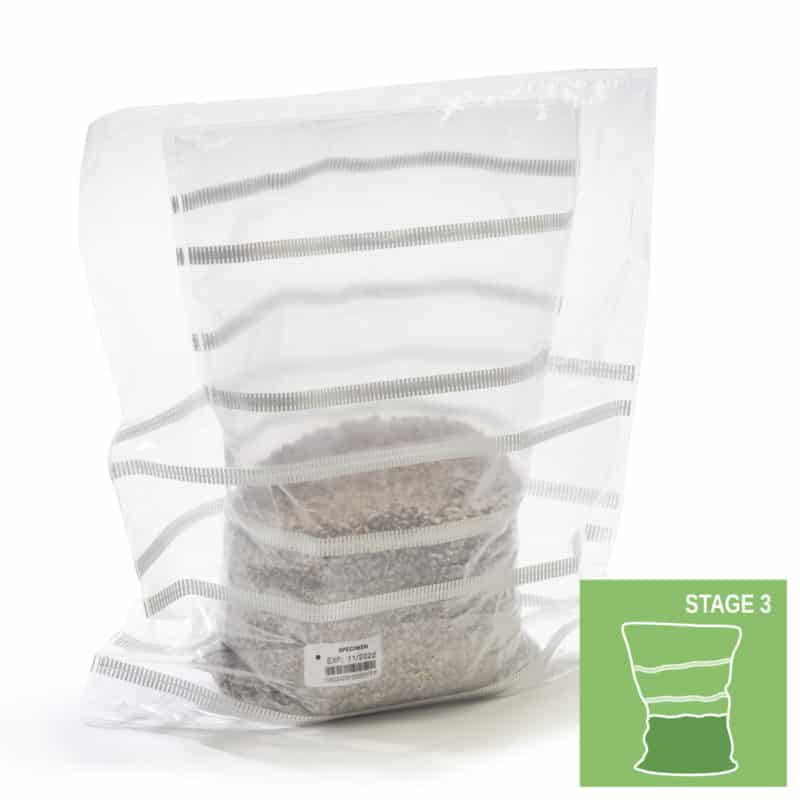
5000 ML BAG
WEIGHT PER BAG: 2,8 – 3,5 KG (DEPENDING ON RECIPE)
Courier freight
Not refrigerated. No shipments during summer.
4 bags/box = 20 litres = 11,2 to 14 kg
Pallet freight (>18 bags) Refrigerated transport all year. Fixed price per pallet depending on delivery address.
3 bags/box = 25 litres = 8,4 to 10,5 kg
36 boxes/europallet = 108 bags = 540 liters = 302 to 378 kg
SPAWN | STAGE 4
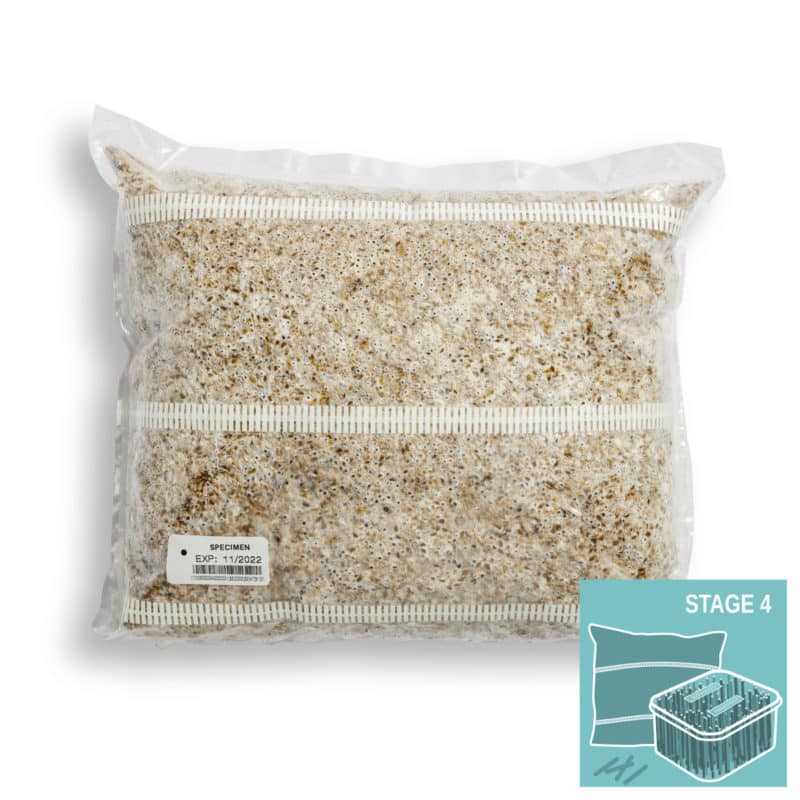
5L BAG
WEIGHT PER BAG: 2,8 – 3,5 KG (DEPENDING ON RECIPE)
Courier freight
Not refrigerated. No shipments during summer.
4 bags/box = 20 litres = 11,2 to 14 kg
Pallet freight (>24 bags)
Refrigerated transport all year. Fixed price per pallet depending on delivery address.
5 bags/box = 25 litres = 14 to 17,5 kg
36 boxes/europallet = 180 bags = 900 liters = 504 to 630 kg
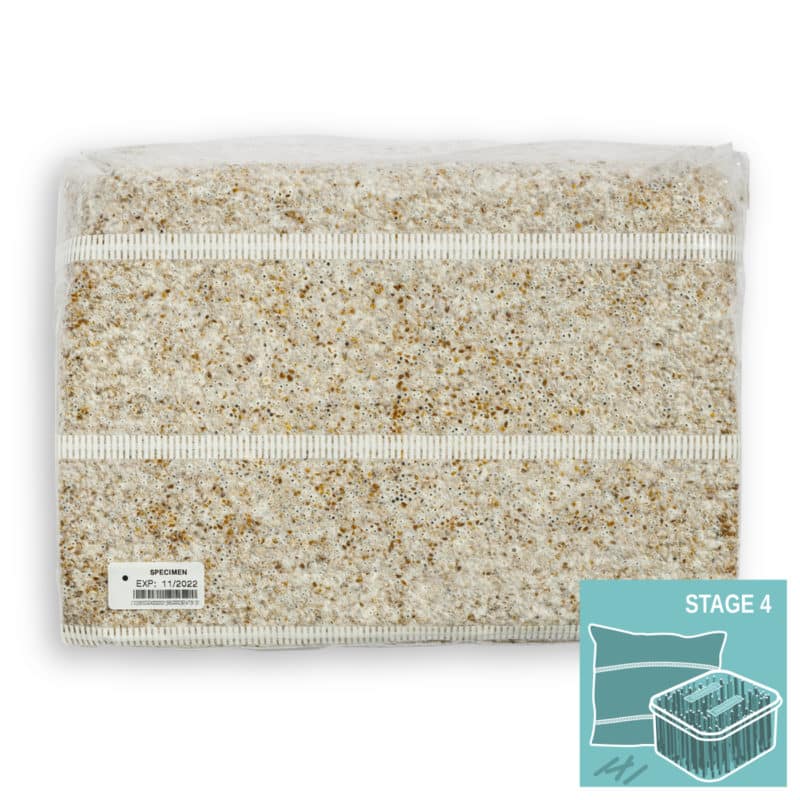
10L BAG
WEIGHT PER BAG: 5,6 – 7 KG (DEPENDING ON RECIPE)
Courier freight
Not refrigerated. No shipments during summer.
2 bags/box = 20 litres = 11,2 to 14 kg
Pallet freight (>12 bags)
Refrigerated transport all year. Fixed price per pallet depending on delivery address.
2 bags/box = 20 litres = 11,2 to 14 kg
48 boxes/europallet = 96 bags = 960 liters = 538 to 672 kg
Prices of larger quantities are to be discussed on a personal level.
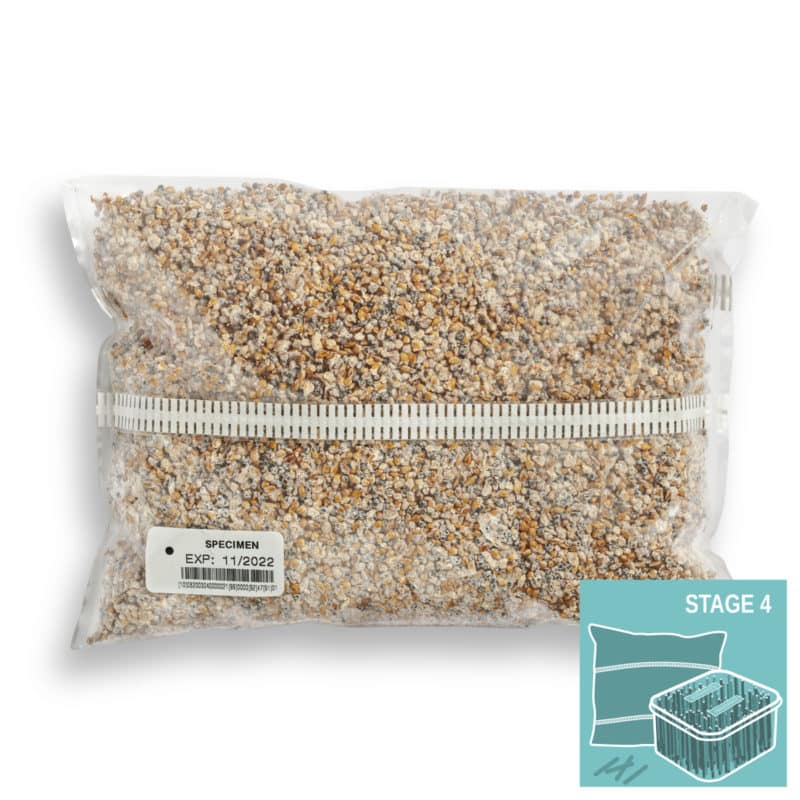
1L BAG
WEIGHT PER BAG: 0,5 – 0,68 KG (DEPENDING ON RECIPE)
Courier freight
Not refrigerated. No shipments during summer.
20 bags/box = 20 litres = 10 – 13,6 kg
Pallet freight (>120 bags)
Refrigerated transport all year. Fixed price per pallet depending on delivery address.
20 bags/box = 20 litres = 10 – 13,6 kg
36 boxes/europallet = 720 bags = 720 liters = 360 – 490 kg
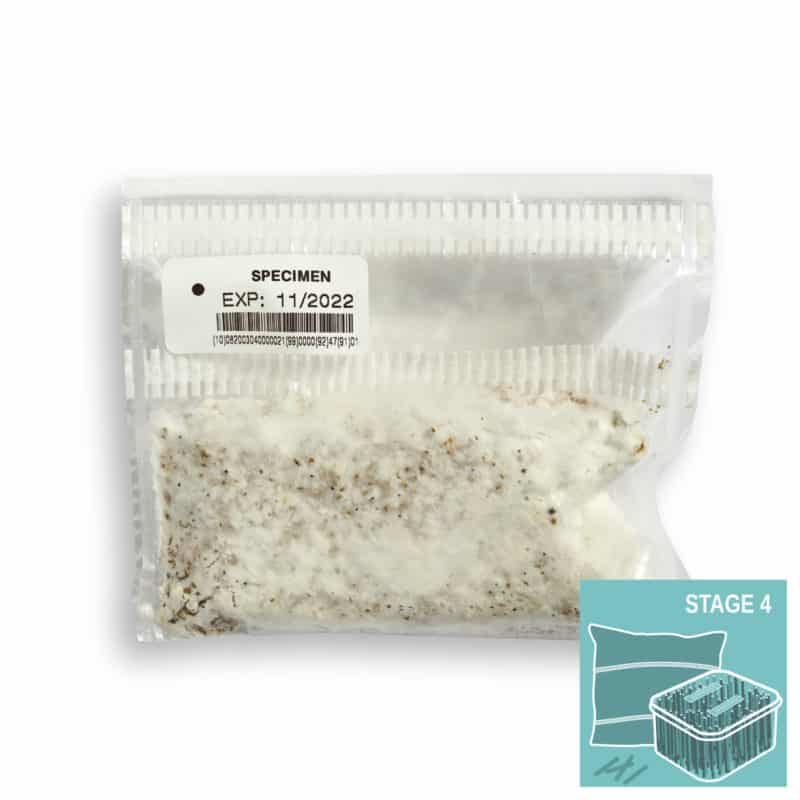
50 GR BAG
WEIGHT PER BAG: 50 GR
Courier freight
Not refrigerated. No shipments during summer. .
100 bags/box = 5 litres = 3 to 3,5 kg
Pallet freight (>600 bags)
Refrigerated transport all year. Fixed price per pallet depending on delivery address.
100 bags/box = 5 litres = 3 – 3,5 kg
36 boxes/europallet = 3600 bags = 180 liters = 108 – 126 k
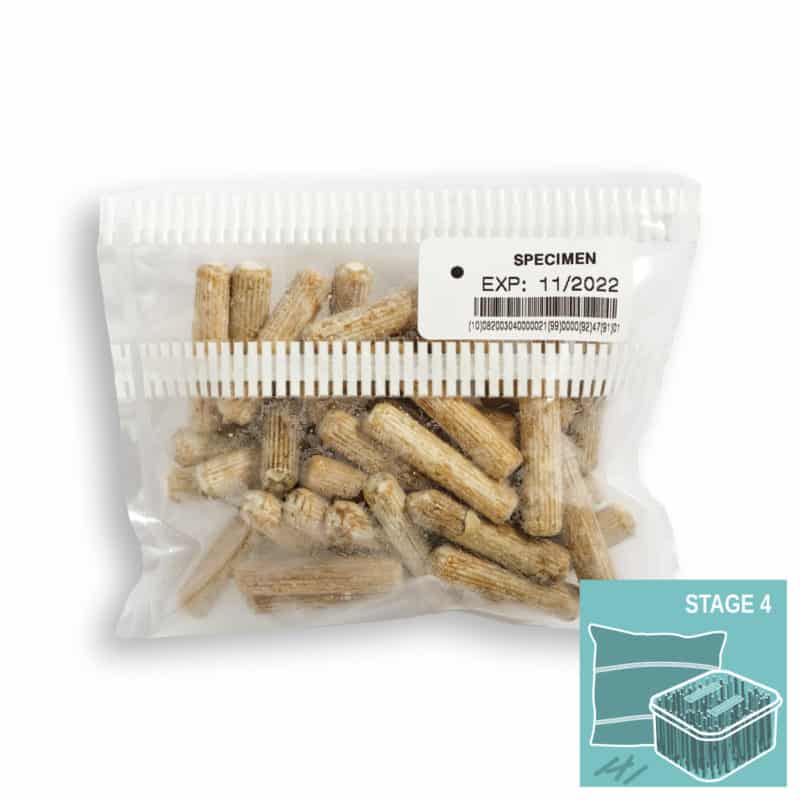
WOOD DOWELS - 50 PCS.
WEIGHT PER BAG: 0,14 – 0,15 KG
Courier freight
Not refrigerated. Limited risk of overheating, even in summer.
80 bags/box = 4000 pcs. = 11,2 – 12 kg
Pallet freight (>480 bags)
Refrigerated transport all year. Fixed price per pallet depending on delivery address.
80 bags/box = 4000 pcs. = 11,2 – 12 kg
36 boxes/europallet = 2880 bags = 144.000 pcs. = 403 – 432 kg
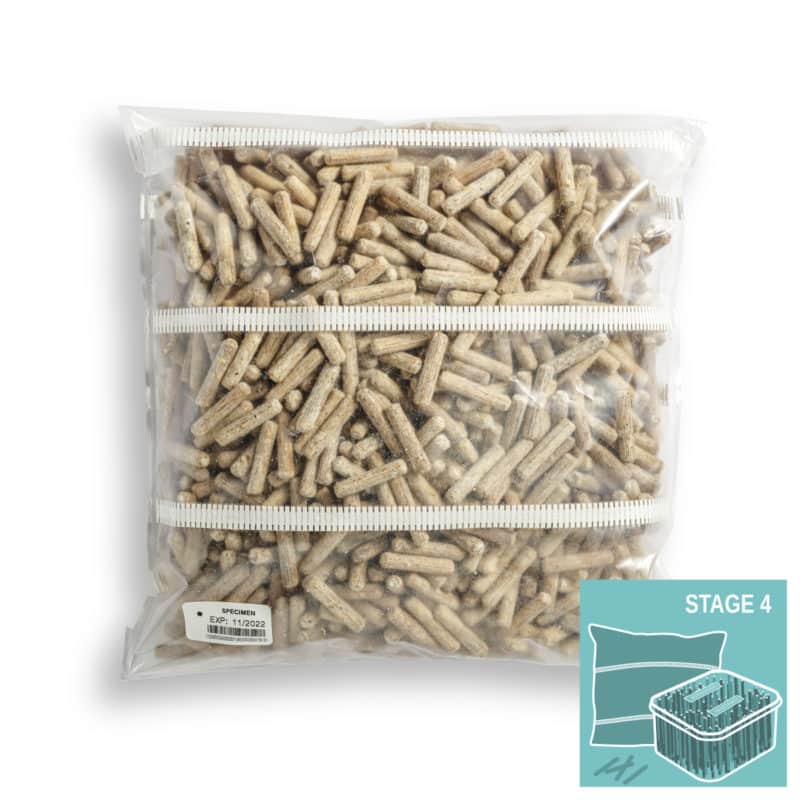
WOOD DOWELS - 1000 PCS.
WEIGHT PER BAG: 2,8 – 3 KG
Courier freight
Not refrigerated. Limited risk of overheating, even in summer.
4 bags/box = 4000 pcs. = 11,2 – 12 kg
Pallet freight (>24 bags)
Refrigerated transport all year. Fixed price per pallet depending on delivery address.
5 bags/box = 5000 pcs. = 14 – 15 kg
36 boxes/europallet = 180 bags = 180.000 pcs. = 504 – 540 kg
About us
Mycelia is a biotechnology company that produces your mycelium at different stages of development: mother cultures, mother spawn and spawn. Our spinoff Mycelia Academy can assist you with consultancy and training. Our R&D department Mycovision can help you develop your products for the mushroom industry or biocontrol market. Read more
SIGN UP TO OUR NEWSLETTER
Receive updates about mushroom spawn and research innovations.
Proud organisers of the WoodFungi Conference

Stage 1 mother culture
PRODUCTS:
– tube
– petri dish
– cryovial
USE:
– Use this product to produce your STAGE 2
Stage 2 mother spawn
PRODUCTS:
– syringe (15 ml)
– syringe (500 ml)
– bag (1000 ml)
USE:
– Use this product to produce your STAGE 3
Stage 3 Inoculum
PRODUCTS:
– bag (5000 ml on grains)
USE:
– Use this product to produce your STAGE 4
Stage 4 spawn
PRODUCTS:
– 50GR, 1L, 5L and 10L bag
– wood dowels 50, 500 and 1000 pcs
– syringes
USE:
– Use this product to produce your STAGE 5
– Final product: biocontrol / biostimulants / Cordyceps substrate
Stage 5 substrate /Mycomaterials
We do not sell substrate or mycomaterials.
Stage 6 mushrooms
We do not sell mushrooms.